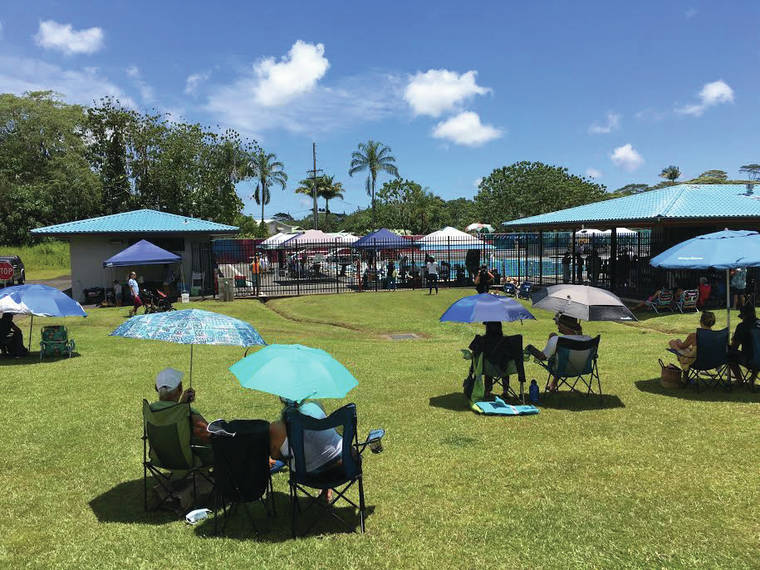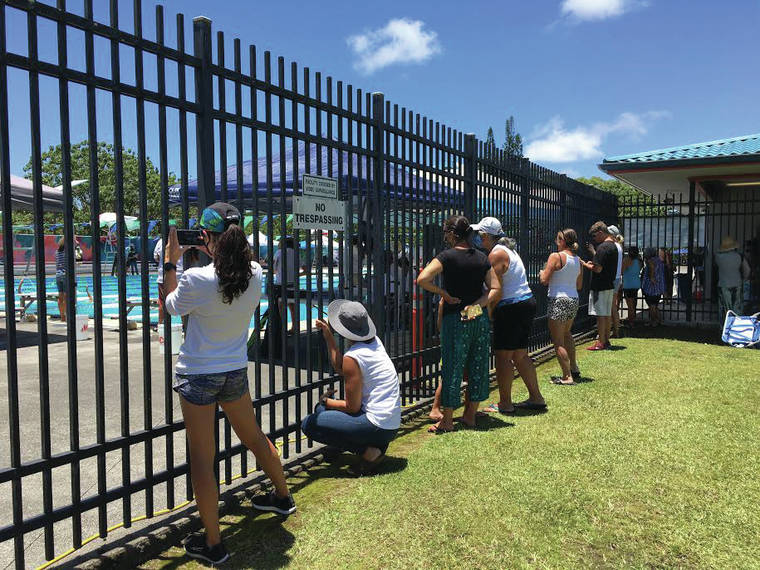This July marks a year since Hawaii Island County swimming pools re-opened to the public after being closed for four months due to COVID-19, and much has changed.
What started off with individual lap swimming of one person per lane for a 45-minute duration has since blossomed to allow more programs and organizations pool usage across the island. While Masters and age-group swim teams returned to morning and afternoon swim sessions in early January, with the heat of summer now in full swing, the county pools seem to be busier than ever.
Alejandra Flores-Morikami, the Recreation Specialist I for the County of Hawaii Aquatics Division, confirmed that much has changed since our initial interview last July.
“We are coming up on one year with our county pools being open and as you are familiar, we started with just a couple days per week being open to the public,” Flores-Morikami said. “We have since opened to more lap swimming and also incorporating our swim lessons and our recreational swims.”
Flores-Morikami said currently all county pools are offering swim lessons for young children and adults, and most have some kind of recreational swim option for families. All organized swim teams are back and the county recently had their first junior lifeguarding class in Hilo last week.
“We are trying to run the gamut, trying to see what our communities really need,” she said. “But of course, that also depends on pool availability and instructor availability.
Our main goal was to be able to offer more programs without taking away anything from swim teams that use our pools, and not take away from what the public already has. We also have a bunch of our pools offering swim times for our county Summer Fun Program, so we have a ton of stuff to add during the summer.”
With summer temperatures on the rise, Flores-Morikami said county pools have seen an uptick in attendance. For the most part, county personnel accommodates the public as best as they can.
“If people from the same household want to come (lap) swimming and they are fine with sharing a lane, we let them do that,” she said. “Even the recreation swims are 45 minutes. The majority of our pools have some kind of recreation swim, or a family swimming option. The bigger pools require a pre-sign up or registration because we don’t want families to come and we have to turn away the kids because we are full.”
Four of the more popular pools on the island currently require pre-registration for pool use. Pahoa Community Aquatic Center requires families to sign up for use of the Keiki Pool, while Kawamoto Pool in Hilo, Konawaena Pool and Kona Community Aquatic Center in West Hawaii require a pre-sign up for recreation use.
“Pre-registration means to reserve a time slot so that we can accommodate all the families that want to come,” she said. “Our favorite clientele are the children, and we don’t want to see them cry because we are full. We just want to accommodate as many people in the pool as we can.”
Parents of age-group swimmers across the island have expressed frustration and wondered when will restrictions be lifted so they can watch their child from the bleachers during swim practice or at a swim meet. Most wait an hour or two inside of their vehicles in the sunbaked pool parking lot with no view of their child swimming.
“There are a couple of different things limiting (parents) from coming in,” Flores-Morikami said. “The first would be the gathering size rules for the county. We are bound to obey those rules first and foremost. That’s a major obstacle and I don’t know when those will change. Until limits on people are removed it’s going to be difficult especially because we try to make it consistent across the board island wide. We also have varying amount of team-use across the island. For instance, at Kawamoto Pool, we have two teams running with a swim lesson and lap swimming all concurrent, at the same pool, at the same time. So, it’s not feasible for us to allow any spectators. Our personnel have a primary duty to ensure safety and that’s where it gets sticky and tricky. When we have a pool that is already close to its limit, and then trying to police who the chosen spectators might be would be difficult.”
Flores-Morikami added safety is the number one priority along with having a consistent standard for all County pools on the island in regards to not allowing spectators inside the facility until there is a change to the Hawaii County guidelines on gathering size. Currently, Flores-Morikami said county pools have been operating and following Hawaii County indoor sporting guidelines that limits gathering size to 25 individuals.
“I don’t know when things are really going to change,” she said. “Everyone keeps asking me when are going to go back? I think the real question is where are we going to go when we move forward? I don’t think that ‘going back’ is the ideal situation. I think this pandemic has really given us a pause and a time to reflect and examine how we want to move forward.”
Flores-Morikami said that as a parent of young active children herself, she would like to offer a glimmer of hope to other “parking lot parents.”
“I would like to commiserate as I also have to watch from my vehicle, but I think the hope that all of us as parents share is that we just want to maintain safety for our children and I think that extends to the greater community. I think that by being cautious in the way we move forward, we can reach that level of community safety sooner and restrictions will ease once we are able to figure out how we will go forward, and how we will make it work. I think together we can really achieve that. So, from parent to parent, bottom line is safety and I think that extends to the greater community.”


